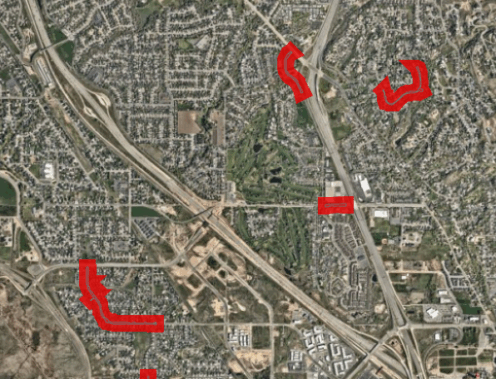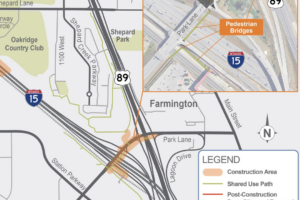Farmington City Storm Water Department
160 South Main Street, Farmington, UT 84025
7:00 AM – 4:00 PM Monday-Friday
801-939-9286
Farmington City Public Works
720 West 100 North, Farmington, UT 84025
8:00 AM – 5:00 PM Monday-Thursday
8:00 AM – 12:00 PM Friday
Reporting Spills and Illegal Dumping
Emergency / Immediate Danger to Health Call 911
For other Spill/ Dumping problems contact
Farmington City Storm Water: 801-939-9286
Farmington City Public Works: 801-451-2624
For other Spill/ Dumping problems after hours contact
Davis County Environmental Health Hotline: 801-525-5100
For problems on construction sites, please call Farmington City Storm Water 801-939-9286
Farmington City Storm Water Management Program
Farmington City is required to comply with “Phase II” storm water regulations under the Clean Water Act. The City has a Storm Drain Management Program intended to meet the regulations and prevent pollution from entering our waterways. Comments, concerns and questions in relation to this program are welcomed, including reports of concerns on construction sites within Farmington City’s limits. Please direct communication to:
Brent White: brwhite@farmington.utah.gov or 801-939-9286
Farmington City has a Small MS4 General UPDES Permit, UTR090006, in conjunction with the State of Utah Department of Environmental Quality. This authorizes the City to discharge stormwater to “waters of the State”. Pursuant to UPDES Permit 4.0 Farmington City has developed a Storm Water Management Plan (SWMP) to convey stormwater discharges compliantly. This SWMP guides Farmington City in the administration of items from Public Outreach & Education, to how Building Permits are issued. Your input on this SWMP is valuable, and considered; diverse opinions can help build a more efficient SWMP. Please study, or skim this document and email me your comments to brwhite@farmington.utah.gov
Municipal Separate Storm Sewer System (MS4) permit
Farmington City Storm Water Management Program: Farmington City SWMP
Farmington City Standard Operating Procedures for MS4: SOP’s
Farmington City Storm Water Ordinance: Title 16 of Farmington City Ordinance
Storm Water Information for Contractors
Owners and Operators of projects disturbing one acre or more of land or projects disturbing less than one acre that are within a common plan of development that disturbs one acre or more of land surface are required to get a Construction Storm Water Permit.
Before Construction Begins:
- Complete Storm Water Pollution Prevention Plan (SWPPP)
- Single family sites disturbing less than 1 acre may use the simplified Utah Common Plan Permit
- Projects disturbing more than 1 acre will need to use the Utah Construction General Permit
- State of Utah Notice of Intent (NOI)
Links to both permits, links for submitting the NOI for permit coverage, and Templates for SWPPPs of each type may be found on the Utah Division of Water Quality website: https://deq.utah.gov/water-quality/storm-water-permits-updes-permits (Under Construction Tab)
- Submit a copy of the SWPPP and NOI to Farmington City Storm Water to brwhite@famington.utah.gov in PDF format.
The SWPPP will be reviewed per the SWPPP Checklists:
CGP Checklist
CPP Checklist
After SWPPP has been reviewed and found acceptable
- Implement the SWPPP on site as applicable for phase 1 of construction, and then schedule the pre-construction meeting & on-site inspection. (Both of these meetings are mandatory prior to any land disturbing activities commence.)
- Acquire a Farmington City Land Disturbance Permit and Storm Water Bond
- Pay fees assessed by Farmington City
- Permit fee is $450, this covers all inspections throughout the duration of the project.
- Post Bond assessed by Farmington City ($700+$1,100/ acre disturbed not to exceed $4,000)
During Construction:
- Continue keeping SWPPP implemented on-site and update as appropriate.
- Perform self-inspections as indicated by the SWPPP and the State of Utah Storm Water General Permit Inspection Guide for Operators
- The contractor must schedule an inspection for any long-term controls as they are being installed on site. (i.e. detention/retention ponds, infiltration basins, etc.)
If you would like to waive the electronic inspection, fill out the waiver and send it to brwhite@farmington.utah.gov
Farmington City will do monthly oversite inspections as required (bi-weekly for “high-priority” sites)
After Construction/Project Close-Out:
- Site must be stabilized (landscaped) and clean.
- Temporary storm water controls must be removed.
- Complete and file a State of Utah Notice of Termination (NOT).
- Submit as-built plans for any Long-Term storm water management controls. (i.e. detention basins, rain gardens, etc.)
- as-built plans must include design and maintenance standards for the controls.
- as-built plans must be stamped by a Professional Engineer.
- Schedule a final storm water inspection at 801-939-9286.
Bond may be released after the conditions above are met and the final inspection is passed.
Best Management Practices (BMPs) Farmington City Preferred BMP List
Of the linked BMPs, Farmington City has selected the following list as preferred BMPs for construction.
- BMP 1 – Portable Toilet on Pervious Surface
- BMP 3 – Curb Sedimentation Trap
- BMP 4 – Concrete Washout Pan
- BMP 13 – Silt Fence
- BMP 21 – Solid Waste Management
- BMP 30 – Manual Mud Removal
- BMP 32 – Street Sweeping
- BMP 33 – Fugitive Dust Control Plan
- BMP 34 – Vegetation Removal Phasing
- BMP 35 – Stabilization Plan
- BMP 36 – Stockpile Management
- BMP 39 – Construction Dewatering DEQ Permit Required
Storm Water Information for Developers
Projects greater than 1 acre of disturbance will consider Low-Impact Development methods. Per the UPDES Permit Farmington holds all development >1 acre must plan to retain the 80th percentile storm event on site in order to mimic the pre-development hydrology and reduce storm water pollution reaching waters of the State.
You can find more information here:
https://deq.utah.gov/water-quality/low-impact-development
Farmington City will also require the following documents/reports prior to approval of a development/redevelopment.
- Hydrological Study: Design will consider pervious and impervious areas of the proposed development or redevelopment under the 80th percentile storm event. As of 2020 the 80th percentile storm event is 0.49” in 24-hours for Farmington City. Calculations will need to be completed and submitted to the City documenting the design parameters of the LID facilities.
- Geotechnical Study: Prior to proceeding with design, soils testing and an associated soils report need to be completed and submitted to the City to document subsurface conditions at each individual site. The geotechnical report must include (at a minimum) percolation rates, groundwater levels, and soil type (including whether the soils are collapsible).
- Water Quality Study: Utah Department of Water Quality A Guide to Low-Impact Development Within Utah Appendix B provides a Storm Water Quality Report Template. This must be completed prior to approval of the development. Additional items such as proposed site-specific pollutants, distance of LID BMP to the nearest State Water, and water quality controls proposed prior to retention are to be included. Storm Water Quality Report form
- Long-Term Storm Water Management Plan & Agreement: The property owner is required to work with the City Engineer, or his/her designee, to create a Long-Term Storm Water Management Plan (LTSWMP) and follow its requirements. All onsite LID facilities will be owned and maintained by the property owner, unless the City agrees otherwise. The facilities will need to be designed in a way that allows the City to access, inspect and possibly maintain them.
Farmington City Long-Term Stormwater Management Agreement
USWAC Stormwater System O&M Plan Template
Residents
Stormwater runoff plays a large role in our local water quality. As precipitation hits the ground and flows across hard or impervious surfaces, it picks up pollutants and carries them into local waterways, such as Farmington Pond, canals, and our beautiful creeks before eventually making its way into the Great Salt Lake. Before development occurs, a variety of plants would act as filters that clean pollution from the water as it percolates into the ground. Without these natural filters, pollutants and other debris accumulate and are washed into bodies of water through the Storm Drain system. Everything that is on our roads is washed into our storm drain system. In addition to transporting pollutants, runoff can also cause erosion and sedimentation by sweeping away and displacing soil which could cause localized flooding.
Resources to Learn More
Automotive Shops
Fueling Stations
Landscaping
Mobile Cleaners
Pools and Spas
Septic System
Farmington City is currently targeting the following pollutants as they have been detected in our waterways:
Floodplain Permit
For questions contact Brent White Brwhite@farmington.utah.gov or (801) 939-9286.
What is a Floodplain?
This is land around our bodies of water that takes on excess water when there is a flood. If we manage them wisely, we can reduce the risk of life safety issues arising and property damage when snowmelt or a heavy storm overwhelm the banks.
Why are Floodplains important?
We are not only concerned about safety and property, we are also concerned about clean water. A healthy floodplain gives water space to spread out and slow down. This keeps the water cleaner, and gives our aquafers a chance to use that water to get a little recharge.
When do I need a Floodplain Development Permit?
Farmington City Code 11-31-060 states that a development permit shall be obtained before construction or development begins within any area of special flood hazard area.
The Federal Emergency Management Agency (FEMA) provides interactive FLOODPLAIN MAPS for your convenience. This does include a search bar where you can type in your home address to see your potential risk. There are hard copies of these maps located at Farmington City Hall with our Engineering Department. Please remember that water does not care about lines on a map, anywhere precipitation occurs can flood under the right conditions.
FINISHED WITH YOUR PROJECT
Email brwhite@farmington.utah.gov to schedule an “SW Final Site / Grading Inspection”. The submitted site plan (in the process above) will be utilized to ensure your project meets Farmington City standards and has been completed to protect persons, property, and public infrastructure from stormwater. Upon successful completion of the inspection, your Stormwater Bond will be released from the City and mailed to you via a check.







